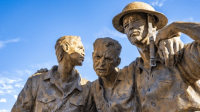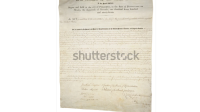Introduction: The Teapot Dome Scandal
The Teapot Dome Scandal of the 1920s remains one of the most notorious and influential political scandals in American history. Centered around the illicit leasing of federal oil reserves, this scandal exposed deep-seated corruption within the federal government and had far-reaching implications for American politics and public trust. The scandal highlighted the darker side of the 1920s, a decade often remembered for its economic prosperity and social change.
The scandal’s name is derived from the Teapot Dome oil field in Wyoming, one of the key locations involved in the corruption. The exposure of the scandal led to a series of investigations and trials, ultimately resulting in significant legal and political repercussions. Understanding the context, key figures, and consequences of the Teapot Dome Scandal provides insight into the challenges of governance and the importance of accountability in public office.
Read Also : The Preamble to the Constitution (1787): A Cornerstone of American Democracy
The Context and Setting: America in the 1920s
To fully appreciate the significance of the Teapot Dome Scandal, it’s essential to understand the political and economic climate of the 1920s. This era, often referred to as the “Roaring Twenties,” was characterized by rapid economic growth, technological innovation, and cultural change. However, it was also a period marked by political corruption and a laissez-faire approach to business regulation. These factors combined to create an environment where corruption could thrive and ultimately lead to one of the most significant political scandals in American history.
The Political Climate of the 1920s
The 1920s were a time of significant transformation in the United States. The end of World War I brought a sense of relief and optimism, leading to a decade of economic prosperity and cultural dynamism. The Harding administration, which took office in 1921, embraced a pro-business stance, advocating for minimal government intervention in the economy. This approach was intended to foster economic growth and stability.
However, the emphasis on business interests and deregulation created an environment ripe for corruption. The political climate was influenced by the belief that government should play a limited role in regulating business practices, leading to close ties between political figures and corporate leaders. This atmosphere set the stage for the Teapot Dome Scandal, as individuals in positions of power exploited their authority for personal gain.
The era’s political landscape was also shaped by a series of scandals and controversies, reflecting broader issues of corruption and governance. The Harding administration, in particular, faced numerous allegations of corruption, with the Teapot Dome Scandal becoming the most infamous example of such unethical behavior. This period of political turbulence highlighted the need for greater oversight and ethical standards in public office.
The Oil Reserves and Their Significance
The Teapot Dome and Elk Hills oil reserves were critical assets for the United States, designated as emergency fuel sources for the Navy. These reserves were established to ensure a stable supply of oil during times of national crisis or conflict. The management and leasing of these reserves became a focal point of political intrigue and corruption.
The importance of the oil reserves extended beyond their strategic value. Oil was a crucial resource for the burgeoning industrial economy, and control over oil production and distribution conferred significant economic and political power. The decision to lease these reserves to private companies, rather than maintaining strict government oversight, was a contentious issue that ultimately led to the scandal.
The strategic value of these oil reserves was a key consideration in their management. Ensuring a reliable supply of oil for the Navy was essential for national security, but the leasing arrangements that emerged from the Teapot Dome Scandal revealed a lack of transparency and accountability in their administration. This mismanagement not only endangered national interests but also eroded public trust in government institutions.
The controversy surrounding the leasing of the oil reserves highlighted the need for greater oversight and ethical standards in the management of public resources. The Teapot Dome Scandal served as a cautionary tale about the dangers of unchecked power and the importance of maintaining integrity in public office. The ramifications of the scandal underscored the need for reforms in government operations and greater vigilance in monitoring the actions of public officials.
The Key Figures in the Teapot Dome Scandal
The Teapot Dome Scandal involved several key figures who played pivotal roles in the events that unfolded. Understanding their involvement helps to shed light on the depth of the corruption and the mechanisms through which it operated.
Albert B. Fall: The Man at the Center
Albert B. Fall, the Secretary of the Interior under President Harding, was the central figure in the Teapot Dome Scandal. Fall, a former senator from New Mexico, was appointed to the Cabinet in 1921. He was responsible for managing public lands and natural resources, including the Teapot Dome and Elk Hills oil reserves.
Fall’s involvement in the scandal began when he secretly negotiated leases for the Teapot Dome and Elk Hills reserves with private oil companies. In exchange for these leases, Fall received substantial bribes, including cash, bonds, and other valuables. His actions were driven by personal gain rather than the public interest, leading to a significant breach of trust.
The discovery of Fall’s corrupt dealings exposed a network of unethical practices within the government. Fall’s willingness to accept bribes and manipulate the leasing process for personal enrichment highlighted the extent of corruption and the need for greater accountability and transparency in public office. His actions ultimately led to his indictment and conviction, making him the first former Cabinet member to be sentenced to prison for crimes committed while in office.
The Oil Tycoons: Doheny and Sinclair
The private oil companies involved in the scandal were headed by two prominent figures: Edward L. Doheny and Harry F. Sinclair. Doheny, a wealthy oil tycoon, was the owner of Pan American Petroleum, which received the lease for the Elk Hills reserve. Sinclair, another influential oil magnate, led the Sinclair Oil Company, which was granted the lease for the Teapot Dome reserve.
Both Doheny and Sinclair were implicated in the scandal for their role in offering bribes to Fall in exchange for the lucrative leases. Their involvement highlighted the close ties between big business and government officials, contributing to the growing concerns about corruption and the undue influence of corporate interests in politics.
The actions of Doheny and Sinclair underscored the broader issue of corporate influence on government policy. Their willingness to engage in corrupt practices for financial gain revealed the lengths to which some business leaders would go to secure advantageous deals. This aspect of the scandal further fueled public outrage and calls for reform.
Warren G. Harding: The Presidential Connection
President Warren G. Harding, who appointed Albert Fall to his Cabinet, was indirectly connected to the scandal. While Harding himself was not directly implicated in the corrupt activities, his administration’s lax oversight and tolerance of unethical behavior created an environment in which such corruption could flourish.
Harding’s leadership style, which emphasized delegation and trust in his appointees, contributed to the lack of scrutiny over Fall’s actions. The Teapot Dome Scandal, along with other controversies during Harding’s tenure, tarnished his legacy and raised questions about his judgment and the effectiveness of his administration.
The scandal’s exposure during Harding’s presidency cast a long shadow over his time in office. It highlighted the need for stronger leadership and more rigorous oversight of government officials to prevent such abuses of power in the future.
The Unraveling of the Scandal: Investigations and Public Outrage
The exposure of the Teapot Dome Scandal was a gradual process, driven by investigative journalism, public inquiry, and formal investigations. These efforts played a crucial role in uncovering the extent of the corruption and holding the responsible parties accountable.
The Role of the Press and Public Inquiry
The Teapot Dome Scandal came to light through investigative journalism and public scrutiny. The press played a crucial role in uncovering the details of the scandal, with reporters and journalists exposing the corrupt dealings between Fall and the oil companies. The relentless reporting drew widespread public attention and outrage, putting pressure on the government to address the issue.
In 1922, Senator Thomas J. Walsh launched a formal investigation into the scandal, leading to a series of hearings that revealed the extent of the corruption. The investigation uncovered evidence of bribery, fraud, and other unethical practices, leading to legal actions against the key figures involved. Walsh’s persistent efforts were instrumental in bringing the scandal to the forefront of public consciousness.
The role of the press and public inquiry in exposing the Teapot Dome Scandal underscored the importance of a free and vigilant press in holding government officials accountable. The investigative efforts not only brought the truth to light but also sparked a broader conversation about the need for ethical governance and transparency in public office.
Senate Investigations: The Walsh Committee
The Senate investigations, spearheaded by Senator Walsh, were crucial in uncovering the details of the Teapot Dome Scandal. The hearings revealed the extent of the corruption, the involvement of high-ranking officials, and the intricate web of deceit that characterized the scandal.
The Walsh Committee’s findings were damning, providing irrefutable evidence of bribery and corruption. The investigations led to the indictment and prosecution of Albert Fall, Edward Doheny, and Harry Sinclair. Fall was eventually convicted of accepting bribes and became the first former Cabinet official to be imprisoned for crimes committed while in office.
The Senate investigations not only exposed the corrupt practices but also highlighted the need for stronger oversight and accountability mechanisms within the government. The scandal prompted calls for reforms to prevent similar abuses of power in the future, leading to increased scrutiny of government actions and the establishment of more robust ethical standards.
Legal Repercussions: Trials and Convictions
The legal repercussions of the Teapot Dome Scandal were significant. The trials and convictions of the key figures involved sent a powerful message about the consequences of corruption and the importance of integrity in public service.
Albert B. Fall was convicted of accepting bribes and sentenced to one year in prison and a fine of $100,000. His conviction marked a historic moment, as he became the first former Cabinet official to be imprisoned for crimes committed while in office. Edward Doheny and Harry Sinclair also faced legal consequences for their roles in the scandal, although their punishments were less severe.
The trials and convictions underscored the seriousness of the offenses and the need for accountability at the highest levels of government. The legal actions taken in response to the Teapot Dome Scandal served as a deterrent to future corruption and reinforced the principle that no one is above the law.
The Impact of the Teapot Dome Scandal
The Teapot Dome Scandal had far-reaching impacts on American politics, governance, and public trust. The revelations of corruption and the subsequent legal actions had lasting effects on the political landscape and led to significant reforms.
Public Trust and Government Accountability
The Teapot Dome Scandal severely eroded public trust in the government. The exposure of high-level corruption and unethical behavior by prominent officials created a sense of disillusionment and skepticism among the American people. The scandal highlighted the need for greater transparency, oversight, and ethical standards in public office.
The erosion of public trust had lasting implications for the relationship between the government and the citizens it serves. The scandal underscored the importance of accountability and the need for mechanisms to ensure that public officials act in the best interests of the people. The call for reforms in the wake of the scandal reflected a broader demand for ethical governance and the restoration of public confidence in government institutions.
Political Reforms and Ethical Standards
The Teapot Dome Scandal prompted significant political reforms and the establishment of stricter ethical standards for public officials. In response to the revelations of corruption, Congress passed legislation aimed at preventing similar abuses of power in the future. These reforms included measures to increase transparency, enhance oversight, and strengthen the penalties for ethical violations.
The establishment of more rigorous ethical standards was a key outcome of the scandal. The reforms sought to create a culture of integrity and accountability within the government, ensuring that public officials adhere to the highest standards of conduct. The legacy of the Teapot Dome Scandal continues to influence contemporary discussions about ethical governance and the importance of maintaining public trust.
Long-Term Consequences for the Oil Industry
The Teapot Dome Scandal also had long-term consequences for the oil industry and the management of natural resources. The revelations of corruption and the subsequent legal actions led to increased scrutiny of the relationships between government officials and private companies. The scandal prompted calls for greater regulation and oversight of the oil industry to prevent similar abuses in the future.
The impact of the scandal extended beyond the immediate legal and political consequences. It highlighted the need for ethical management of natural resources and the importance of maintaining transparency and accountability in dealings between the government and private industry. The lessons learned from the Teapot Dome Scandal continue to inform contemporary discussions about the regulation of the oil industry and the management of public resources.
Conclusion: The Legacy of the Teapot Dome Scandal
The Teapot Dome Scandal remains a defining moment in American history, serving as a powerful reminder of the dangers of corruption and the importance of accountability in public office. The scandal exposed deep-seated corruption within the federal government and had far-reaching implications for American politics and public trust. The legal and political repercussions of the scandal led to significant reforms and the establishment of stricter ethical standards for public officials.
The legacy of the Teapot Dome Scandal continues to influence contemporary discussions about ethical governance and the importance of maintaining public trust in government institutions. The revelations of corruption and the subsequent legal actions serve as a cautionary tale about the dangers of unchecked power and the need for vigilance in monitoring the actions of public officials.
Understanding the context, key figures, and consequences of the Teapot Dome Scandal provides valuable insights into the challenges of governance and the importance of accountability in public office. The lessons learned from the scandal continue to resonate today, reminding us of the need for transparency, integrity, and ethical conduct in all aspects of public life
FAQ About the Teapot Dome Scandal
What was the Teapot Dome Scandal?
The Teapot Dome Scandal was a major political scandal in the 1920s involving the illegal leasing of federal oil reserves in Wyoming and California to private oil companies in exchange for bribes.
Who was involved in the Teapot Dome Scandal?
The scandal involved several key figures, including Albert B. Fall, the Secretary of the Interior, and prominent oil tycoons Edward L. Doheny and Harry F. Sinclair. President Warren G. Harding’s administration was also indirectly connected to the scandal.
What were the consequences of the Teapot Dome Scandal?
The Teapot Dome Scandal led to significant legal and political repercussions, including the indictment and conviction of Albert B. Fall. The scandal also prompted political reforms, the establishment of stricter ethical standards for public officials, and increased scrutiny of the oil industry.
How did the Teapot Dome Scandal come to light?
The scandal was uncovered through investigative journalism and public inquiry, with significant contributions from the press and formal investigations led by Senator Thomas J. Walsh. The relentless efforts of journalists and investigators brought the details of the scandal to public attention.
What is the legacy of the Teapot Dome Scandal?
The Teapot Dome Scandal remains a powerful reminder of the dangers of corruption and the importance of accountability in public office. The scandal’s legacy includes significant political reforms, stricter ethical standards, and ongoing discussions about the need for transparency and integrity in government.







I have read so many posts on the topic of the blogger lovers
but this paragraph is genuinely a nice paragraph, keep it up.
You have a gift for making things stick. chhattisgarh news
Your insights always hit the mark. Water Bottle
I appreciate the effort you put into this. Indian Football
I appreciate the effort you put into this. Indian Cricket
You have a real talent for this subject. Tech News
I know of the fact that nowadays, more and more people are attracted to digital cameras and the discipline of pictures. However, as a photographer, you should first invest so much of your time deciding the model of photographic camera to buy along with moving via store to store just so you could potentially buy the lowest priced camera of the trademark you have decided to pick. But it would not end right now there. You also have take into consideration whether you can purchase a digital digicam extended warranty. Thx for the good recommendations I received from your website.
I just could not depart your site before suggesting that I really enjoyed the standard info a person provide for your visitors? Is going to be back often in order to check up on new posts
Definitely, what a fantastic site and enlightening posts, I surely will bookmark your site.Have an awsome day!
The articles you write help me a lot and I like the topic http://www.hairstylesvip.com